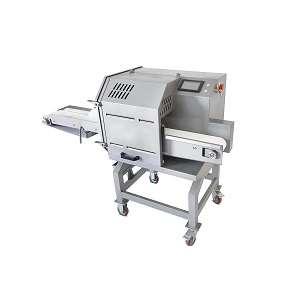Cooked Meat Slicer is one of the common kitchen equipment in the catering industry. It is used to cut grilled meat into thin slices, such as ham, roast beef, etc. To ensure proper functioning, long service life and food safety, regular maintenance is essential. Below are maintenance guidelines for your barbecue slicer, including routine, scheduled and preventive maintenance.

Routine maintenance
Clean the surface of the machine: Clean the surface of Cooked meat slicer with a damp cloth after each use. Make sure to remove any remaining food crumbs and grease to avoid bacterial growth and keep the unit looking tidy.
Clean the blades and cutter disc: Clean the blades and cutter disc of your barbecue slicer regularly. Use warm water and mild detergent to clean the blades, making sure to remove food residue. After cleaning, dry the blade with a clean towel to prevent rust.
Lubricate moving parts: Check your barbecue slicer's moving parts, such as bearings and transmissions. Apply food-grade lubricants regularly to ensure smooth operation of moving parts and reduce wear.
Check the wires and switches: Regularly check the power cord and switch of Cooked meat slicer to ensure that the power cord is not damaged or aged and that the switch is flexible and reliable. If damage or failure is found, replace or repair it in time.
Maintain good ventilation: Make sure there is good ventilation around Cooked meat slicer to prevent food odors and fumes from building up. Clean vents and fans regularly to keep air flowing.
Regular maintenance
Blade Wear Check: Regularly inspect your barbecue slicer blades to make sure they are sharp and not worn. If you find that the blade is severely worn or the cutting effect becomes poor, replace the blade in time to ensure the quality of the slices.
Clean the bottom tray: Regularly clean the bottom tray of Cooked meat slicer to remove food residue and grease in the tray. Use warm water and mild detergent for cleaning to ensure the bottom is clean and hygienic.
Check safety equipment: Regularly check your barbecue slicer's safety equipment, such as blade guards and emergency stop buttons. Ensure safety equipment is intact and reliable to avoid accidental injuries.
Clean the transmission: Regularly clean the transmission of your barbecue slicer, including the gears and drive belts. Make sure the transmission is clean to avoid the accumulation of grease and food debris and reduce friction and wear.
Check machine stability: Regularly check the stability of your barbecue slicer to make sure the unit is securely placed and not wobbling or wobbling. If the machine is found to be unstable, adjust the supporting feet in time to keep it level.
preventive maintenance
Periodic maintenance schedule: Develop a periodic maintenance schedule for your barbecue slicer, including cleaning, lubrication, inspection and maintenance. Develop maintenance plans for different periods based on the frequency of use of the equipment and the working environment.
Employee training: Train employees who use Cooked meat slicer to teach them proper operation and maintenance techniques. Cultivate employees' maintenance awareness and reduce equipment misoperation and damage.
Spare parts reserve: Reserve commonly used spare parts for barbecue slicers, such as blades, bearings and transmission belts. Ensure timely replacement of spare parts to avoid equipment downtime due to lack of spare parts.
Regular inspection and maintenance: Regularly conduct comprehensive inspection and maintenance of Cooked meat slicer, including cleaning, lubrication, replacement of wearing parts, etc. Deal with problems promptly to prevent equipment failure or damage.
The above maintenance guide can help ensure the normal operation of Cooked meat slicer, extend its service life and ensure food safety. Regular and preventive maintenance is key to keeping equipment running efficiently and providing restaurants with a safe and reliable food processing environment.




